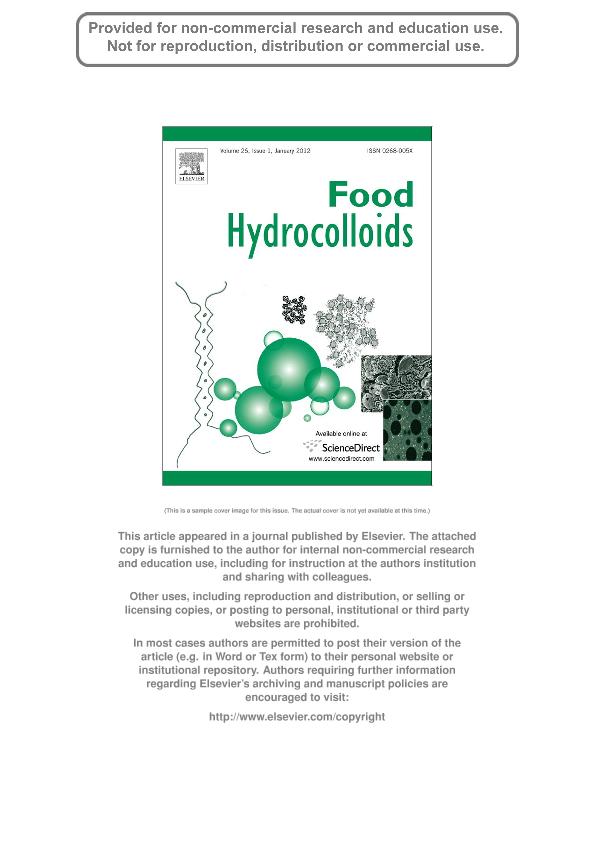Mostrar el registro sencillo del ítem
dc.contributor.author
Fissore, Eliana Noemi

dc.contributor.author
Rojas, Ana Maria Luisa

dc.contributor.author
Gerschenson, Lia Noemi

dc.contributor.author
Williams, Peter A.
dc.date.available
2017-05-02T17:58:34Z
dc.date.issued
2013-06
dc.identifier.citation
Fissore, Eliana Noemi; Rojas, Ana Maria Luisa; Gerschenson, Lia Noemi; Williams, Peter A.; Butternut and beetroot pectins: characterization and functional properties; Elsevier; Food Hydrocolloids; 31; 2; 6-2013; 172-182
dc.identifier.issn
0268-005X
dc.identifier.uri
http://hdl.handle.net/11336/15860
dc.description.abstract
The physicochemical characteristics and functional properties of butternut (Cucumis moschata Duch. ex Poiret) and beetroot (Beta vulgaris L. var. conditiva) pectins obtained by enzymatic extraction from by-products of vegetable processing have been evaluated. The molecular mass distribution was determined using Gel Permeation Chromatography using light scattering, refractive index and UV detectors and the samples were found to be highly heterogeneous and polydisperse. Mw values of 136,000 and 1,309,000 g/mol were determined for butternut and beetroot pectins respectively. Butternut pectin had a high degree of methyl esterification. In the presence of high concentrations of sugar and at low pH, this pectin did not form gels but instead produced viscous solutions. Solutions showed pseudoplastic flow behaviour with a shear thinning index of 0.68 as determined from the Power law model. Beetroot pectin had a low degree of methyl esterification and formed gels with addition of Ca2+ at concentrations of 10 mg/g pectin or higher. The maximum value of the storage modulus was obtained at a Ca2+/GalA ratio of 0.25. The thermal stability of gels suggested that hydrogen bond interactions prevailed in the absence of Ca2+, whereas electrostatic junction zones increasingly developed between pectin chains as the calcium concentration increased. Aqueous solutions of butternut and beetroot pectins significantly reduced surface tension and both samples were able to form stable oil-in-water emulsions. It was found that protein and/or polyphenol – rich fractions present in the pectins adsorbed at the oil–water interface and were responsible for the emulsification properties.
dc.format
application/pdf
dc.language.iso
eng
dc.publisher
Elsevier

dc.rights
info:eu-repo/semantics/openAccess
dc.rights.uri
https://creativecommons.org/licenses/by-nc-nd/2.5/ar/
dc.subject
Butternut Pectin
dc.subject
Beetroot Pectina
dc.subject
Functional Properties
dc.subject.classification
Alimentos y Bebidas

dc.subject.classification
Otras Ingenierías y Tecnologías

dc.subject.classification
INGENIERÍAS Y TECNOLOGÍAS

dc.title
Butternut and beetroot pectins: characterization and functional properties
dc.type
info:eu-repo/semantics/article
dc.type
info:ar-repo/semantics/artículo
dc.type
info:eu-repo/semantics/publishedVersion
dc.date.updated
2017-04-28T20:29:06Z
dc.journal.volume
31
dc.journal.number
2
dc.journal.pagination
172-182
dc.journal.pais
Países Bajos

dc.journal.ciudad
Amsterdam
dc.description.fil
Fil: Fissore, Eliana Noemi. Universidad de Buenos Aires. Facultad de Ciencias Exactas y Naturales. Departamento de Industrias; Argentina. Consejo Nacional de Investigaciones Científicas y Técnicas; Argentina
dc.description.fil
Fil: Rojas, Ana Maria Luisa. Universidad de Buenos Aires. Facultad de Ciencias Exactas y Naturales. Departamento de Industrias; Argentina. Consejo Nacional de Investigaciones Científicas y Técnicas; Argentina
dc.description.fil
Fil: Gerschenson, Lia Noemi. Universidad de Buenos Aires. Facultad de Ciencias Exactas y Naturales. Departamento de Industrias; Argentina. Consejo Nacional de Investigaciones Científicas y Técnicas; Argentina
dc.description.fil
Fil: Williams, Peter A.. Glyndwr University Wrexham; Reino Unido
dc.journal.title
Food Hydrocolloids

dc.relation.alternativeid
info:eu-repo/semantics/altIdentifier/doi/http://dx.doi.org/10.1016/j.foodhyd.2012.10.012
dc.relation.alternativeid
info:eu-repo/semantics/altIdentifier/url/http://www.sciencedirect.com/science/article/pii/S0268005X1200238X
Archivos asociados
